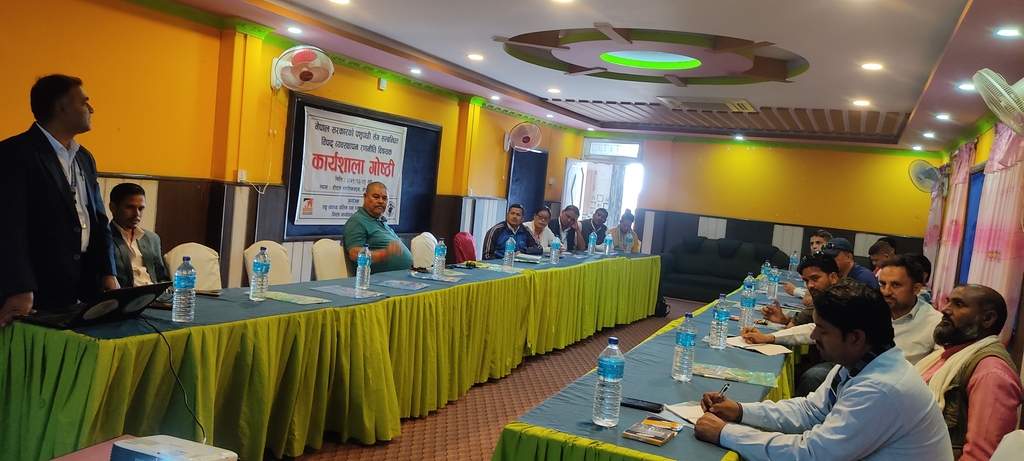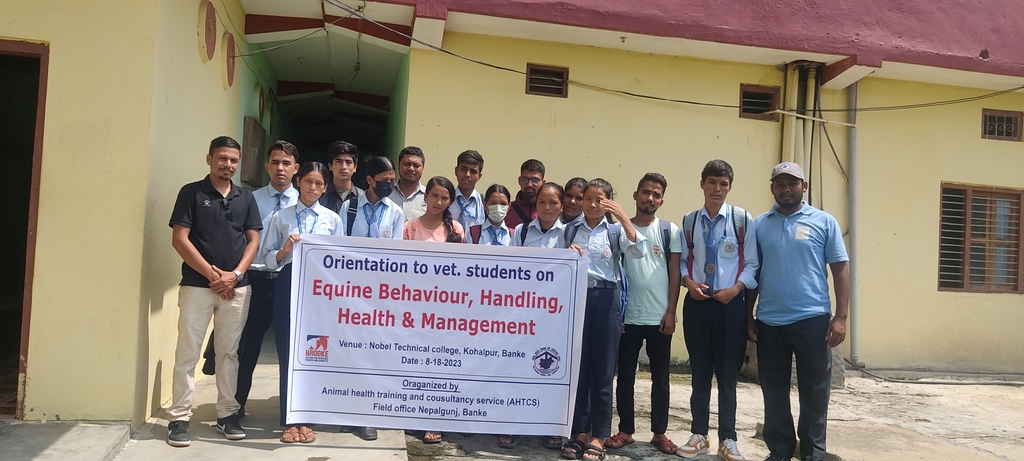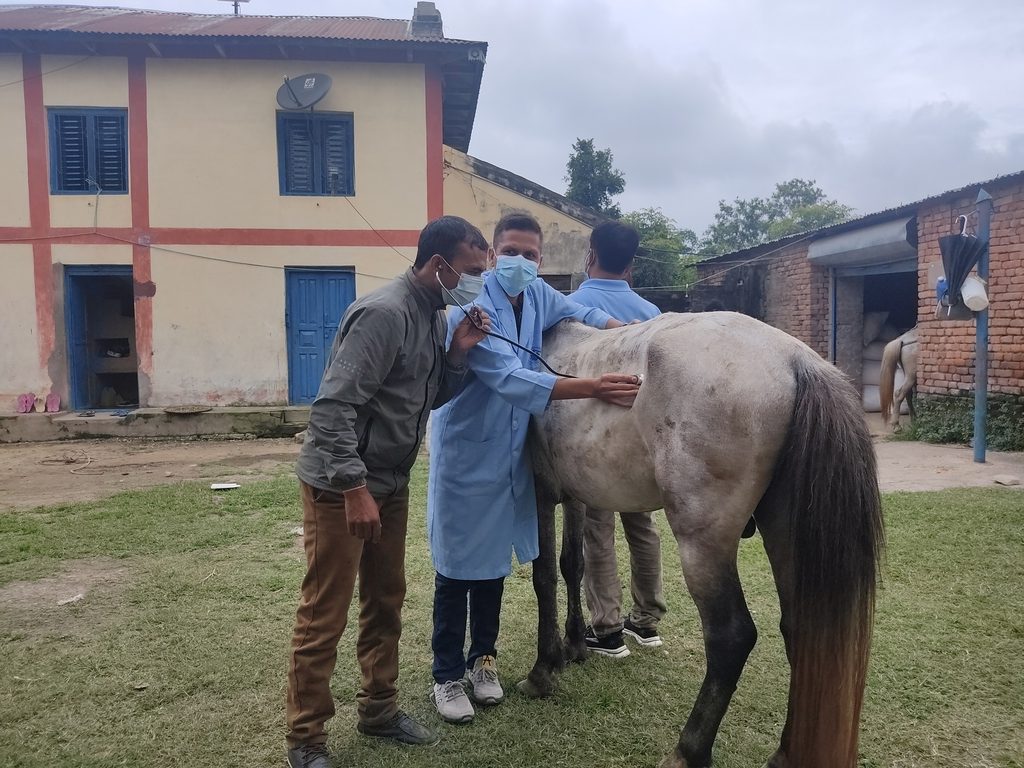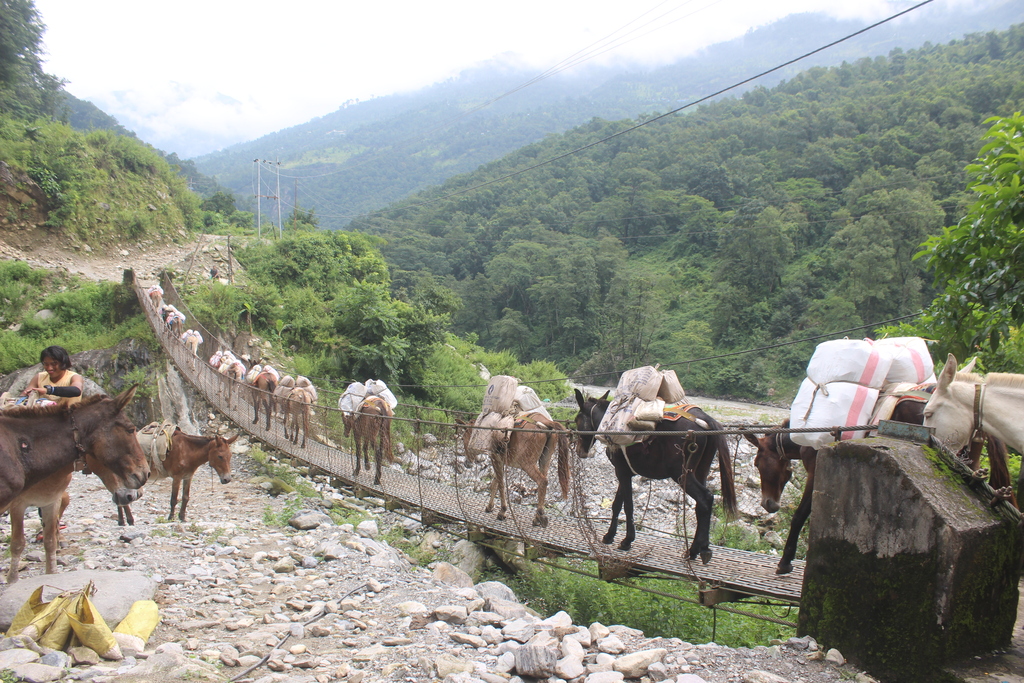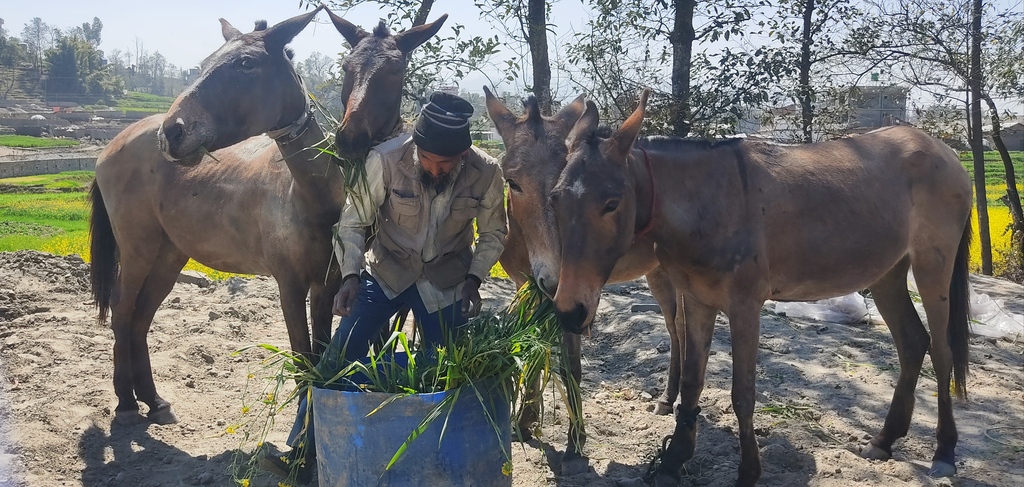Supporting Agency: Brooke-Action for Working Horses and Donkeys, UK
Implementing Partners: Animal Health Training and Consultancy Service (AHTCS), Nepal
Duration: 2007-Running
Theme: Equine Health and Welfare
Sub Sectors: Equine Behavior, Equine Health, Equine Welfare, Community Engagement, Livelihood Promotion, Behavior Change, Veterinary Service Provision, Policy advocacy, Coordination and Collaboration, Equine Welfare in Brick Industries
Project Description
Sustainable Equine Welfare through Project (SEWP)
Horses and mules were the major transportation means in the past and used to transport goods and people. Extension of roadway and physical infrastructure has limited the animal’s use. However, even today considerable equine population are still engaged, especially in the hills and high mountains. Similarly, Brick Kilns in Terai and mid hilly region, employs equids to draft work during brick kiln operation season (October to May/June). Further, the use of equids in promoting tourism as well as cultural rituals and festive has gained notable attraction. Overall, equid sector accounts for major livelihood generation avenue for numerous families and communities all over Nepal and has significant contribution to local as well as national economy.
Equine remains one of the severely neglected sectors of Nepal and are often overlooked in the plans and policies. National policies have failed to describe equids; they are neither considered livestock nor companion animals and are thus excluded from national priorities; harsh reflection facing equine sector. Similarly, horses and mules represent one of the most exploited animals and are subjected to a heavy workload. Debilitated horses and mules limping with unbearable workload and wounds all over the body were a common sight in the Brick Kilns of Nepal. Brick Kilns represent one of the most challenging work-setting for animals where equids are exposed to extreme working environment with negligible care. Compromised nutrition, poor shed, extreme walking terrains and minimal veterinary care further compounds and worsens the health and welfare status of equids. Furthermore, equine rearing communities are marginalized in every means with below par livelihood status amid illiteracy, resource deficit and limited livelihood opportunities. Equine rearing communities and associated professions are held in low esteem and considered inferior by the outsiders. Amid limited resources and minimal income, equine owners could barely provide for their families let alone the animals.
Poor animal healthcare system and limited technical workforce further compounds the health and welfare status. Veterinary professionals lack appropriate skills and knowledge on equine practice. The national academic curriculum doesn’t favor the cause either. The unavailability of equine specific medicine and inadequate workforce with limited competency leads to compromised medical care.
Poor biosecurity measures, subpar nutrition, negligible care and extreme work stress expose equids to high risk of various diseases and health conditions, some fatal than others. Colic, lameness, wound, trypanosomiasis, tetanus and respiratory ailments represent major health concerns. Glanders, a notifiable zoonoses was first recorded in 2020 and is on the rise which not only affects equids but also threatens public health.
AHTCS in partnership with Brooke Hospital for Animals UK, a leading animal welfare charity, has been implementing Sustainable Equine Welfare through Improved Human Behavior and Working Environment Project (SEWP) across several districts of Nepal since 2007. The project aims to improve the overall health and welfare of the working equids and strengthen the livelihood resilience of the equine owning communities. The strategic framework is tailored with due consideration of the immediate and long-term needs of the target beneficiaries.
During initial years of operation, interventions were more directed towards sensitizing the end users i.e. equine owners and handlers on animal health and welfare and provide free direct veterinary health care. However, with the changing scenario of working equid welfare there has been a gradual shift in paradigm regarding our intervention strategy over the years. Based on the observation and experience of initial years, various stakeholders and networks were identified as fundamental to achieve sustainable change and a novel modified approach was formulated that incorporates diversified multilevel stakeholders into the program i.e. Equine owners/handlers, BK owners, BK association, Local media, LSPs (Private and Governmental), Governmental authority, Policy makers, etc. The interventions were focused on enhancing equine owner’s capacity to undertake basic management practice, capacity building of the LSPs and their mobilization, sensitizing the BK owners, governmental and local level authority and policy makers on animal welfare issues and animal welfare legislations and on top of that to educate individual stakeholders on their personal and collective roles and responsibilities pertaining animal welfare.
Community Engagement, Local Capacity Strengthening, Strnegthening animal healthcare system, Coordination among the key stakeholders and Advocacy constitutes the core component of the project with a vision of establishing self-sufficient communities with responsible ownership and a robust animal health care system in place to ensure the sustainable improvement in health and well-being of equids as well as communities. Projects reach was extended to more than 30 districts across Terai and hills and high mountain regions of Nepal.
Goals and Expected Outcomes
Goal 1.: Transforming equid welfare in communities helping them thrive and become more resilient
- Improved equine welfare enhanced livelihood resilience in the communities
- Equine welfare practice improved in the communities and brick kilns
- Equine owner’s access to govt. subsidized services increased in communities and brick kilns
- Working environment and infrastructural change led to improve equine welfare in brick kilns
- animal welfare policies implemented in brick kilns
Goal 2. Influence the visibility and inclusion of equid needs in policy and practices at all levels, including disaster and emergency preparedness
- Ensure inclusion of Equids into govt. policy and plans (all three tiers)
- Stakeholders realized to include equids in govt. livestock services
- Equine owner’s access to govt. veterinary services increased in communities and brick kilns
- Equids are included into livestock emergency plans
- Community led Initial livestock emergency preparedness plan developed
- Initial brick kiln emergency preparedness plan for equids developed
Goal 3. Develop sustainable animal health systems that meet the immediate and future needs of working horses, donkeys and mules.
- Increasing in technical efficiency, engagement and workforce in equine health services contributed to sustainable animal health system
- Equines communities and brick kilns have access to quality animal healthcare service
- Introduced and promoted one health one welfare approach in the programmatic areas
- Improved knowledge and practice of equine owners on equine health led to increase service seeking behavior in communities and brick kilns
- Equine owner’s capacity enhanced to undertake basic equine health, disease and management practices
- Service seeking behavior of equine owners increased in communities and brick kilns
Key Interventions and Operational Strategies:
- Community Engagement and Livelihood Resilience:
Horses and humans share a close connection, their health and welfare are intrinsically linked. Families with sustainable livelihood could only be open for investment in the improvement of health and wellbeing of their animals. Equine owning communities face many constraints including illiteracy, lack of livelihood capitals and are poorly represented in the government’s priorities. AHTCS emphasizes uniting the communities to better raise their voices. The number of panels installed for monitoring CCTV is not as per requirement. Income from equids accounts for the only livelihood options for most of the equine communities and they often struggle to ensure the essentials their families, let alone animals. In the light of the scenario, AHTCS helps communities to diversify their livelihood alternatives while ensuring equine remains at the center of the interventions. Equine Welfare Groups (EWG) are formed and mobilized. The groups are registered and well recognized at the government level, ensuring communities continue to enjoy the available services and facilities while being better protected at the policy level. Savings and credit mobilization within the group provides financial comfort to the farmers in need, members can borrow loans at affordable rates to support their livelihood ventures. Further, these groups relate to microfinance, cooperatives, banks and other support groups helping them to ease their financial hardships.
Communities are engaged in monthly EWG meetings and sensitized on equine husbandry practices, contemporary issues, leadership, entrepreneurship, livelihood, resilience, etc. through various interventions. AHTCS believes that the welfare status of equines and livelihood status of the owners are positively correlated and goes hand on hand. AHTCS has been providing diversified livelihood opportunities to the equine owners to boost their resilience and secure better living conditions for both humans and the animals and make sure the communities are self-sufficient with local system in place ensuring sustainable impacts.
- Human behavior transformation:
AHTCS acknowledges and prioritizes human behavior as key to bring change of any magnitude. One’s behavior shapes the way in which he/she perceives the surroundings, their thought process and overall action in general. So, for any ideas to transform into success, behavioral modification becomes imperative. Project interventions encourage self-realization, responsible ownership, peer learning and motivation as well as enforce reward and punishment measures in a sensible way to promote human behavior change. Animals, like humans, are sentient beings and are capable of experiencing complex emotions ranging from pain, fear, anxiety, joy, gratitude, etc. Once people truly realize this, behavior change gradually unfolds. Reduction of malpractices and promotion of welfare friendly humane handling practices as well as enhanced service seeking behavior reflects the positive behavior transformation over the course of project.
- Capacity building of equine owners:
Equine owners remain the key actor in the animal welfare chain as they are the ones responsible for day-to-day care of the animals. It is crucial to transform their attitude and strengthen their knowledge and skill and ensure that they are reflected in their practices to realize optimum health and welfare of the animals. Equine owners are oriented on animal welfare, good husbandry practices (nutrition, housing), primary care (grooming, eye care, hoof care), first aid and preventive measures, common health issues and their management including vaccination, deworming, wound management, etc. as well as humane handling practices. Furthermore, equine owners are oriented on local level planning and decision-making processes to ensure they are better represented at policy level.
- Sustainable Animal Healthcare System:
Weak Animal Healthcare System (AHS) compromises the quality of health and wellbeing of animals and could lead up to implications affecting not only animals but humans too. While the global veterinary practice advocates for innovations, Nepal is still struggling to establish basic veterinary service provision in the remote areas. Equine related healthcare provisions are limited to non-existent. Animal Healthcare System (AHS) includes Animal Healthcare Providers (AHPs), veterinary hospitals, clinics and similar institutions, agrovet and medicine suppliers, laboratories, quarantines authorities, public health authorities, research and extension as well as plans and policies governing AHS. Furthermore, services like farrier and hair clippers are also covered. Strengthening of all the components in unison could lead to sustainable AHS. Lack of competent technical workforce, unavailability of medicines, weak surveillance and diagnostics as well as accessibility and affordability in part of communities are the major healthcare problems facing equine. Drugs misuse by equine owners has surfaced in recent times. Global concerns like AMR and disease outbreak have telling effects on animal human interface, further stressing the need to promote one health approach.
AHTCS works towards creating a system where ailing animals get quality, accessible and affordable veterinary care. Capacity building of the AHPs via training, medicine and equipment support, networking and mobilization in the communities as well as regular mentoring and monitoring is the foundation to ensure accessible quality veterinary service provision in the communities. Work with the agrovets and medicine suppliers contributes to the availability of medicines in the market. Similarly, government veterinary bodies and professionals are the integral component of the project, and we invest in capacity building of those institutions for sustainable change. Our work with veterinary teaching institutions fosters need based research and development on equine medicine and associated disciplines. To provide exposure to equine practice, aspiring vet graduates and students are engaged in internship programs.
One health interconnects animal health, human health and environmental protection. Our work especially in BKs endorses and promotes one health ensuring health and well-being of humans and animals while promoting environmental conservation. May 2021 marked the first official case of Glanders in Nepal. Animals imported from India are considered to be the source of disease. Open border and poor quarantine regulations doesn’t help the cause either. AHTCS’s focal work with communities, brick industries, government bodies, quarantine authority, diagnostics laboratories, public health bodies supported community awareness, timely detection and diagnosis of disease as well as adoption of the biosecurity measures. Advocacy works on appropriate policies are ongoing.
Through our work we attempt to establish a sustainable animal healthcare system capable of addressing the immediate as well as future needs of equids where no ailing animals must experience unwanted pain and distress.
- Advocacy:
The Equine sector remains invisible in government’s policies and priorities. Despite contributing significantly to local and national economy, equines often are neglected. National policies have failed to describe equids; they are neither considered livestock nor companion animals and are thus excluded from national priorities; harsh reflection facing equine sector.
AHTCS continues to work with policy makers at all three levels (local, provincial and national) to advocate for the inclusion and protection of equids in legal framework. AHTCS supports the enforcement, implementation and evidence-based amendment of the existing policies while at the same time advocating for the formulation of appropriate policies at all levels. AHTCS contributed to the development of the Animal Welfare Directive-2073, a legal framework defining optimum welfare standards for working animals. Now, AWD guides AHTCS’s work in Brick Industries. Amid AHTCS’s decade long association with local government bodies, communities continue to enjoy vet treatment support, subsidized support schemes, livestock and agriculture enterprise support programs, equids are included in animal health camp and vaccination campaign and several local bodies have allocated budget and programs to support livelihood of equine owning communities.
AHTCS’s contribution to national policies includes input in drafting Animal Welfare Act and Infectious Disease Act. Our effort has led to the inclusion of equids in the national livestock insurance program, however few constraints have prevented its effective implementation. We seek to influence the government to endorse and implement Essential Veterinary Medicines List (EVML), a comprehensive record of core veterinary medicines developed jointly by Brooke and WVA. Equine specific syllabus has been integrated in the Village Animal Health Worker’s (VAHW) training to produce community level technical workforce. Furthermore, our partnership with vet teaching institutions and universities has contributed to the inclusion of equine topics in their curriculum. Sustainable impact warrants a conducive policy environment and AHTCS continues to work with policy makers and influencers to promote inclusion and protection of equids and dependent communities at policy level.
- Coordination and Collaboration:
Coordination and collaboration are the vital components of sustainable development. AHTCS believes and adheres to 3Cs; Communication, Coordination and Collaboration. Right from the planning to implementation phase, all major actors are involved to ensure relevancy, effectiveness, impact and sustainability of the interventions. Communities, BK Associations, Government bodies, veterinary professionals and institutions as well as concerned development agencies are the identified collaborative entities. So far, this module has led to several successful ventures with changes sustained beyond the duration of the project. Communities and local systems continue to assume the ownership of the responsibilities leading to sustainable impact.
- Brick Kiln Interventions:
Brick Kiln is a seasonal industry and operates from October to May/June. There are more than 1100 registered Brick Kilns in Nepal, particularly concentrated in terai regions and few hilly districts. Equids (Horse and Mule) are put to draft work, majority of which are imported from adjoining districts of India. Debilitated horses and mules limping with unbearable workload and wounds all over the body were a common sight in the Brick Kilns of Nepal. Brick Kilns represent one of the most challenging work-setting for animals where equids are exposed to extreme working environment with negligible care. Compromised nutrition, poor shed, extreme walking terrains, exploitative workload and working hours and minimal veterinary care compounded by poor socio-economic status of the communities further worsens the health and welfare status of equids.
Animal Welfare Directives-2073 (AWD) guides AHTCS’s work in Brick Industries. Our standards regarding optimum nutrition, housing facilities, appropriate workload and work hours, working environment, physical infrastructures, veterinary care and such are adherent to AWD. Reduction of cruelty and malpractices and promotion of welfare friendly humane practices remains forefront. Brick Kiln Interventions is an intensive, holistic multilevel stakeholder engagement approach that aims to bring together diverse beneficiaries and stakeholders to foster all round improvement of the components that influence or have tendency to influence health and welfare of the animals working in the Brick Industries. Equine owners/handlers and equine owning families/communities are the key beneficiaries while Brick Kiln Owner/Manager, BK Association and Federation, Government units, Veterinary professionals and other local Service Providers (farriers, hair clipper, feed vendor, etc.), policy makers as well as other like-minded agencies remains key stakeholders. The interventions are focused on enhancing equine owner’s capacity to undertake basic management practice, capacity building of the LSPs and their mobilization, sensitizing the BK owners, governmental and local level authority and policy makers on animal welfare issues and animal welfare legislations and on top of that individual stakeholders are educated on their personal and collective roles and responsibilities pertaining animal welfare. The impact so far has been encouraging with AWD being implemented in more than 70% of the targeted BKs. The BKs have improved physical infrastructure and working environment including comfortable housing, nutrition, drinking facilities, isolation box, first aid kit box, plain walking terrain, appropriate workload and working hours as well as accessible animal healthcare services. Similarly, we promote one health approach in BKs as equine owners and their families share a common environment and are in close contact with animals, thus increasing
AHTCS was awarded the leading animal welfare organization by the Federation of Nepal Brick Industries (FNBI) in recognition of the contributions to the improvement of overall health and welfare of the equids working in the Brick Industries.


